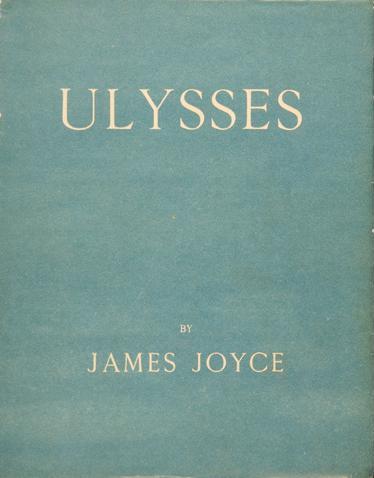
Stream of consciousness
In literary criticism, stream of consciousness is a narrative mode or method that attempts "to depict the multitudinous thoughts and feelings which pass through the mind" of a narrator.[1]
This article is about the literary device. For the pre-writing technique, see Free writing. For other uses, see Stream of consciousness (disambiguation).Better known, perhaps, is the 1855 usage by Alexander Bain in the first edition of The Senses and the Intellect, when he wrote, "The concurrence of Sensations in one common stream of consciousness–on the same cerebral highway–enables those of different senses to be associated as readily as the sensations of the same sense".[2] But it is commonly credited to William James who used it in 1890 in his The Principles of Psychology. In 1918, the novelist May Sinclair (1863–1946) first applied the term stream of consciousness, in a literary context, when discussing Dorothy Richardson's novels.[3] Pointed Roofs (1915), the first work in Richardson's series of 13 semi-autobiographical novels titled Pilgrimage,[4] is the first complete stream-of-consciousness novel published in English. However, in 1934, Richardson comments that "Proust, James Joyce, Virginia Woolf, and D.R. ... were all using 'the new method', though very differently, simultaneously".[5] There were, however, many earlier precursors and the technique is still used by contemporary writers.
Development[edit]
Beginnings to 1900[edit]
While the use of the narrative technique of stream of consciousness is usually associated with modernist novelists in the first part of the twentieth century, several precursors have been suggested, including Laurence Sterne's psychological novel Tristram Shandy (1757).[11] John Neal in his novel Seventy-Six (1823) also used an early form of this writing style, characterized by long sentences with multiple qualifiers and expressions of anxiety from the narrator.[12] Prior to the 19th century, associationist philosophers, like Thomas Hobbes and Bishop Berkeley, discussed the concept of the "train of thought".
It has also been suggested that Edgar Allan Poe's short story "The Tell-Tale Heart" (1843) foreshadows this literary technique in the nineteenth century.[13] Poe's story is a first person narrative, told by an unnamed narrator who endeavours to convince the reader of his sanity while describing a murder he committed, and it is often read as a dramatic monologue.[14] George R. Clay notes that Leo Tolstoy, "when the occasion requires it ... applies Modernist stream of consciousness technique" in both War and Peace (1869) and Anna Karenina (1878).[15]
The short story, "An Occurrence at Owl Creek Bridge" (1890), by another American author, Ambrose Bierce, also abandons strict linear time to record the internal consciousness of the protagonist.[16] Because of his renunciation of chronology in favor of free association, Édouard Dujardin's Les Lauriers sont coupés (1887) is also an important precursor. Indeed, James Joyce "picked up a copy of Dujardin's novel ... in Paris in 1903" and "acknowledged a certain borrowing from it".[17]
Some point to Anton Chekhov's short stories and plays (1881–1904)[18] and Knut Hamsun's Hunger (1890), and Mysteries (1892) as offering glimpses of the use of stream of consciousness as a narrative technique at the end of the nineteenth century.[19] While Hunger is widely seen as a classic of world literature and a groundbreaking modernist novel, Mysteries is also considered a pioneer work. It has been claimed that Hamsun was way ahead of his time with the use of stream of consciousness in two chapters in particular of this novel.[20][21] British author Robert Ferguson said: "There’s a lot of dreamlike aspects of Mysteries. In that book ... it is ... two chapters, where he invents stream of consciousness writing, in the early 1890s. This was long before Dorothy Richardson, Virginia Woolf and James Joyce".[21] Henry James has also been suggested as a significant precursor, in a work as early as Portrait of a Lady (1881).[22] It has been suggested that he influenced later stream-of-consciousness writers, including Virginia Woolf, who not only read some of his novels but also wrote essays about them.[23]
However, it has also been argued that Arthur Schnitzler (1862–1931), in his short story '"Leutnant Gustl" ("None but the Brave", 1900), was the first to make full use of the stream of consciousness technique.[24]
Early twentieth century[edit]
It was not until the twentieth century that this technique was fully developed by modernists. Marcel Proust is often presented as an early example of a writer using the stream of consciousness technique in his novel sequence À la recherche du temps perdu (1913–1927) (In Search of Lost Time), but Robert Humphrey comments that Proust "is concerned only with the reminiscent aspect of consciousness" and that he "was deliberately recapturing the past to communicate; hence he did not write a stream-of-consciousness novel".[25] Novelist John Cowper Powys also argues that Proust did not use stream of consciousness: "while we are told what the hero thinks or what Swann thinks we are told this rather by the author than either by the 'I' of the story or by Charles Swann."[26]
Song lyrics[edit]
Stream of consciousness technique is also used in song lyrics.[49] Songwriters such as Sun Kil Moon[50][51] and Courtney Barnett[52] use it in their songs. An early example is Outkast's song "A Life in the Day of Benjamin André (Incomplete)" off their 2003 album Speakerboxxx/The Love Below.[53]
Dialogue in films[edit]
Some filmmakers use the narrative technique. For example, the documentary Anonymous Club about songwriter Courtney Barnett is narrated using stream-of-consciousness.[54] Terrence Malick's films use it as well.[55] 2022 film You Won't Be Alone also uses it.[56]